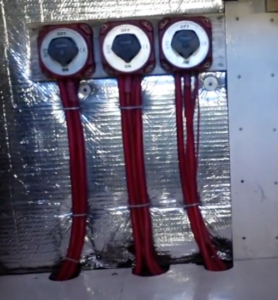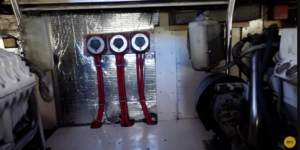February 26, 2025
Fuel Pump and Injector System Overview
Fuel System Components in Cummins ISM, ISMe, and QSM11
Key Fuel System Components and Their Functions
Common Symptoms of Fuel System Issues
Step-by-Step Fuel Pump Inspection and Maintenance
Step 1: Diagnosing Fuel Pump Issues
Step 2: Fuel Pump Removal and Replacement
Step-by-Step Fuel Injector Inspection and Service
Step 1: Diagnosing Fuel Injector Issues
Step 2: Fuel Injector Removal and Replacement
Fuel Line Inspection and Replacement
Step 1: Inspecting Fuel Lines for Wear and Leaks
Step 2: Replacing Fuel Lines
Final Notes on Fuel System Maintenance for Cummins ISM, ISMe, and QSM11
Read More
February 26, 2025
Cam Follower Removal and Replacement
Safety and Preparation Before Cam Follower Removal
Personal Protective Equipment (PPE)
Work Area and Tool Preparation
Essential Tools for Cam Follower Removal and Replacement
Step-by-Step Cam Follower Removal and Inspection Procedures
Step 1: Engine Preparation for Cam Follower Removal
Step 2: Cam Follower Removal Procedure
Step 3: Inspecting Cam Followers and Tappets for Wear
Step-by-Step Cam Follower Replacement and Reinstallation
Step 1: Preparing New Cam Followers for Installation
Step 2: Installing the Cam Followers into the Block
Step 3: Reassembling the Valvetrain Components
Step 4: Final System Checks Before Engine Start-Up
Final Notes on Cam Follower Removal and Replacement
Read More
February 26, 2025
Rocker Lever Removal and Inspection Procedures
Safety and Preparation Before Rocker Lever Removal
Personal Protective Equipment (PPE)
Work Area and Tool Preparation
Essential Tools for Rocker Lever Service
Step-by-Step Rocker Lever Removal and Inspection Procedures
Step 1: Engine Preparation Before Rocker Lever Removal
Step 2: Removing the Rocker Lever Assembly
Step 3: Rocker Lever Visual Inspection
Step 4: Checking Rocker Lever Shaft and Oil Supply
Step 5: Checking Rocker Lever Alignment and Straightness
Step-by-Step Rocker Lever Reinstallation
Step 1: Preparing the Rocker Lever Assembly for Installation
Step 2: Adjusting Valve Lash Clearance
Step 3: Reinstalling the Valve Cover and Final Checks
Final Notes on Rocker Lever Inspection for Cummins ISM, ISMe, and QSM11
Read More
February 26, 2025
Cylinder Head Removal, Installation, and Valve and Seat Service
Safety and Preparation Before Cylinder Head Service
Personal Protective Equipment (PPE)
Work Area and Tool Preparation
Essential Tools for Cylinder Head Service
Step-by-Step Cylinder Head Removal and Installation
Step 1: Preparing for Cylinder Head Removal
Step 2: Cylinder Head Removal Procedure
Step 3: Cylinder Head Inspection and Cleaning
Valve and Seat Service for Cummins ISM, ISMe, and QSM11
Step 1: Removing Valves and Springs
Step 2: Reconditioning Valves and Seats
Step 3: Installing Valves and Springs
Cylinder Head Installation Procedures
Step 1: Preparing for Cylinder Head Installation
Step 2: Cylinder Head Bolt Tightening Procedure
Step 3: Final System Checks
Final Notes on Cylinder Head Maintenance for Cummins ISM, ISMe, and QSM11
Read More
February 26, 2025
Cylinder Block Inspection and Repair
Safety and Preparation Before Cylinder Block Service
Personal Protective Equipment (PPE)
Work Area and Tool Preparation
Essential Tools for Cylinder Block Inspection and Repair
Step-by-Step Cylinder Block Inspection and Repair Procedures
Step 1: Visual Inspection of the Cylinder Block
Step 2: Measuring Cylinder Bore Wear
Step 3: Deck Surface Inspection and Flatness Check
Step 4: Cylinder Honing and Liner Replacement
Main Bearing and Crankshaft Service
Step 1: Inspecting the Main Bearings
Step 2: Crankshaft Removal and Inspection
Step 3: Installing New Main Bearings and Reassembling the Crankshaft
Final Checks and Reassembly
Final Notes on Cylinder Block and Crankshaft Service
Read More
February 26, 2025
Engine Removal and Installation Procedures
Parts Catalogs
Safety and Preparation Before Engine Removal
Personal Protective Equipment (PPE)
Work Area Preparation
Step-by-Step Engine Removal Procedures
Step 1: Disconnect the Battery and Electrical Components

Step 2: Drain Fluids and Disconnect the Cooling System

Step 3: Disconnect the Fuel and Air Intake System
Step 4: Unbolt Engine Mounts and Prepare for Lifting
Engine Installation Procedures for Cummins ISM, ISMe, and QSM11
Step 1: Prepare the Engine for Installation
Step 2: Position the Engine in the Chassis
Step 3: Reconnect Fuel, Cooling, and Electrical Systems
Step 4: Perform Initial Startup and System Checks
Final Notes on Engine Removal and Installation for Cummins ISM, ISMe, and QSM11
Read More




 Free US Calls: 1-888-433-4735
Free US Calls: 1-888-433-4735 International: 305-545-5588
International: 305-545-5588

